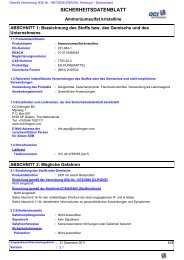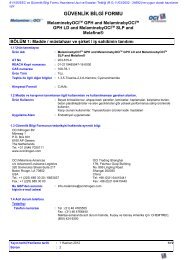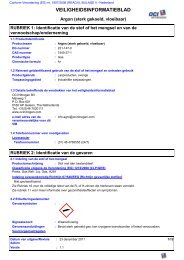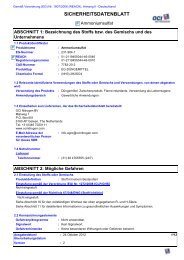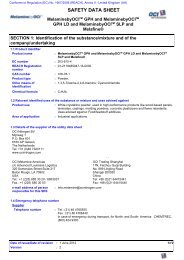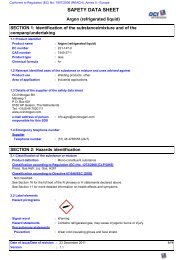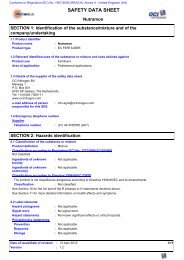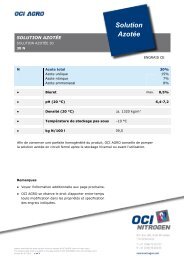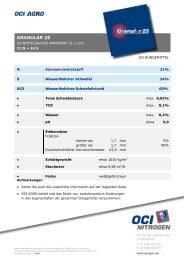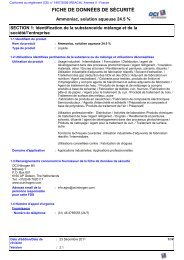PRODUCTION OF AMMONIA - OCI Nitrogen
PRODUCTION OF AMMONIA - OCI Nitrogen
PRODUCTION OF AMMONIA - OCI Nitrogen
Create successful ePaper yourself
Turn your PDF publications into a flip-book with our unique Google optimized e-Paper software.
2.2.5 Partial oxidation of heavy oils<br />
2.2.5.1 Process description<br />
The partial oxidation process is used for the gasification of heavy feedstocks such as residual<br />
oils and coal. Extremely viscous hydrocarbons and plastic wastes may also be used as fractions<br />
of the feed. The partial oxidation process offers an alternative for future utilisation of<br />
such wastes.<br />
An air separation unit is required for the production of oxygen for the partial oxidation<br />
step. The nitrogen is added in the liquid nitrogen wash to remove impurities from the synthesis<br />
gas and to get the required hydrogen/nitrogen ratio in the synthesis gas.<br />
The partial oxidation gasification is a non-catalytic process taking place at high pressure<br />
(>50bar) and temperatures around 1,400°C. Some steam is added for temperature moderation.<br />
The simplified reaction pattern is:-<br />
–CH n – + 0.5O 2<br />
CO + n/2H 2<br />
Carbon dioxide, methane and some soot are formed in addition. The sulphur compounds in<br />
the feed are converted to hydrogen sulphide. Mineral compounds in the feed are transformed<br />
into specific ashes. The process gas is freed from solids by water scrubbing after waste heat<br />
recovery and the soot is recycled to the feed. The ash compounds are drained with the process<br />
condensate and/or together with a part of the soot. In at least two units in Europe, the soot is<br />
separated from soot water in a mainstream filtration stage, to avoid ash build-up in the gasification<br />
cycle downstream units. The heavy metals, such as V, Ni and Fe are recovered. The<br />
hydrogen sulphide in the process gas is separated in a selective absorption step and<br />
reprocessed to elementary sulphur in a Claus unit.<br />
The shift conversion usually has two high temperature shift catalyst beds with intermediate<br />
cooling. Steam for the shift conversion is supplied partially by a cooler-saturator system and<br />
partially by steam injection.<br />
CO 2 is removed by using an absorption agent which might be the same as that in the sulphur<br />
removal step. Residual traces of absorption agent and CO 2 are then removed from the<br />
process gas, before final purification by a liquid nitrogen wash. In this unit practically all the<br />
impurities are removed and nitrogen is added to give the stoichiometric hydrogen to nitrogen<br />
ratio.<br />
The ammonia synthesis is quite similar to that used in steam reforming plants, but simpler<br />
and more efficient, due to the high purity of synthesis gas from liquid nitrogen wash units and<br />
the synthesis loop not requiring a purge.<br />
2.2.5.2 Steam and power system<br />
Auxiliary boilers are required if the compressors are steam-driven. The flue-gas from these<br />
power plants is the main source of emissions which are mainly SO 2 , NO x , and CO 2 . The site<br />
emissions are very low if the compressors are driven by imported electric power.<br />
17



